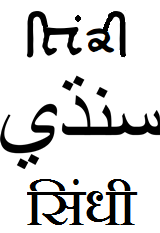Difference between revisions of "Language/Sindhi/Grammar/Conditional-Mood"
m (Quick edit) |
m (Quick edit) |
||
| Line 7: | Line 7: | ||
__TOC__ | __TOC__ | ||
<span link>With the completion of this lesson, consider investigating these related pages: [[Language/Sindhi/Grammar/How-to-Use-Be|How to Use "Be"]], [[Language/Sindhi/Grammar/Future-Tense|Future Tense]], [[Language/Sindhi/Grammar/Adjectives|Adjectives]] & [[Language/Sindhi/Grammar/How-to-Use-Have|How to Use Have]].</span> | |||
== Overview == | == Overview == | ||
The conditional mood in Sindhi is formed by adding the suffixes -ونھ or -ون to the verb stem. The suffix -ونھ is used for verbs ending in a consonant, while the suffix -ون is used for verbs ending in a vowel. | The conditional mood in Sindhi is formed by adding the suffixes -ونھ or -ون to the verb stem. The suffix -ونھ is used for verbs ending in a consonant, while the suffix -ون is used for verbs ending in a vowel. | ||
| Line 31: | Line 33: | ||
<hr>If you have any questions, please ask them in the comments section below.<br>Feel free to edit this wiki page if you think it can be improved. 😎 | <hr>If you have any questions, please ask them in the comments section below.<br>Feel free to edit this wiki page if you think it can be improved. 😎 | ||
==Other Lessons== | |||
== | |||
* [[Language/Sindhi/Grammar/Give-your-Opinion|Give your Opinion]] | * [[Language/Sindhi/Grammar/Give-your-Opinion|Give your Opinion]] | ||
* [[Language/Sindhi/Grammar/How-to-Use-Be|How to Use Be]] | * [[Language/Sindhi/Grammar/How-to-Use-Be|How to Use Be]] | ||
| Line 43: | Line 43: | ||
* [[Language/Sindhi/Grammar/How-to-Use-Have|How to Use Have]] | * [[Language/Sindhi/Grammar/How-to-Use-Have|How to Use Have]] | ||
* [[Language/Sindhi/Grammar/Pronouns|Pronouns]] | * [[Language/Sindhi/Grammar/Pronouns|Pronouns]] | ||
<span class='maj'></span> | <span class='maj'></span> | ||
| Line 50: | Line 49: | ||
{{Sindhi-Page-Bottom}} | {{Sindhi-Page-Bottom}} | ||
<span links></span> | |||
Latest revision as of 20:59, 27 March 2023
Hi Sindhi learners! 😊
In today's lesson, we will be discussing the conditional mood in Sindhi. The conditional mood is used to express a hypothetical situation or an event that may or may not happen in the future. It is also used to express wishes and desires.
With the completion of this lesson, consider investigating these related pages: How to Use "Be", Future Tense, Adjectives & How to Use Have.
Overview[edit | edit source]
The conditional mood in Sindhi is formed by adding the suffixes -ونھ or -ون to the verb stem. The suffix -ونھ is used for verbs ending in a consonant, while the suffix -ون is used for verbs ending in a vowel.
Formation[edit | edit source]
The conditional mood is formed by adding the suffixes -ونھ or -ون to the verb stem. For example, the verb stem of the verb 'to write' is 'لکھ'. To form the conditional mood, the suffix -ونھ is added to the verb stem, resulting in the word 'لکھونھ'.
Examples[edit | edit source]
Here are some examples of verbs in the conditional mood:
- لکھونھ (to write)
- سنونھ (to hear)
- جانونھ (to know)
- پکھونھ (to ask)
- چلونھ (to come)
Usage[edit | edit source]
The conditional mood is used to express a hypothetical situation or an event that may or may not happen in the future. It is also used to express wishes and desires.
For example, the sentence "If I had more time, I would learn Sindhi" can be translated into Sindhi as "اک ڪجھ کان وٺي، منهنجو سنڌي ۾ سڀ کان وٺون".
It can also be used to express a wish or desire. For example, the sentence "I wish I could speak Sindhi" can be translated into Sindhi as "منهنجو سنڌي ۾ بولي چاهيون ٿا".
If you have any questions, please ask them in the comments section below.
Feel free to edit this wiki page if you think it can be improved. 😎
Other Lessons[edit | edit source]
- Give your Opinion
- How to Use Be
- Plurals
- Questions
- Future Tense
- Adjectives
- Negation
- How to Use Have
- Pronouns
Sources[edit | edit source]
